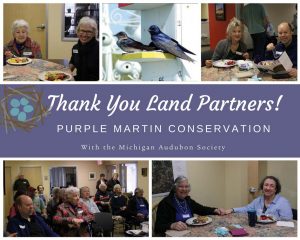 At the 7th Annual Legacy Land Conservancy Partner Gathering, Penny Briscoe, with the Purple Martin Conservation Association and the Michigan Audubon Society, shared tips on how land owners can attract and foster purple martin colonies.
At the 7th Annual Legacy Land Conservancy Partner Gathering, Penny Briscoe, with the Purple Martin Conservation Association and the Michigan Audubon Society, shared tips on how land owners can attract and foster purple martin colonies.
Purple Martins are aerial insectivores, meaning they feed by catching flying insects. Purple Martins are one of the highest-flying foragers and can be seen hundreds of meters in the air. They are frequently found in the Great Lakes region, preferring to breed in the Northern Hemisphere and winter in the Southern Hemisphere. An extremely social species, they love to group together on perches and are not deterred by the presence of people.
In fact, says Briscoe,”Purple Martins want to be around people. They love people. They’re a great city bird.”
Sadly, of the swallow gild, especially in the Great Lakes region, Purple Martins are experiencing the greatest declines, according to Caleb Putnam, Michigan Important Bird Areas Coordinator for The National Audubon Society. The once-thriving population has dwindled to just 10 percent of their numbers in 1880.

Purple Martins only live in human-provided housing. Courtesy of the Purple Martin Conservation Association.
Habitat loss, reduction in food supply, invasive species, and predators have led to this significant drop in the Purple Martin population. A loss of human interest has also been factor, as the birds now only nest in human-provided housing.
The Purple Martin Conservation Association and the Michigan Audubon Society have been working hard to restore the Purple Martin population. They are encouraging land owners to install housing for Purple Martin colonies on their property.
“If you’re going to put up a Purple Martin colony, then you are a citizen scientist, because you can’t put up Purple Martin housing without putting some effort into it,” admits Briscoe.
How to Help
Set up the right house in the right place. Houses are mounted on poles 15’–18’ tall, 40’–60’ away from trees, and 30’–120’ from human residences. Purchase housing from places knowledgeable about Purple Martin needs, such as the Purple Martin Conservation Association. Learn about the best location for a martin house and what type of housing is best for martins at the Purple Martin Conservation Association’s website.
Watch out for predators. Use a pole guard to prevent raccoons, squirrels, or other climbing predators. Install owl/hawk guards to prevent aerial attacks.
Avoid using pesticides in the yard. Insects are Purple Martin food.
Create native plant habitat for insects (martin food) to thrive. Learn about bird-friendly native plants.
Share your experience with others. Invite your neighbors, housing association, or local community leaders to see your birds.
Manage for invasive bird species. Good Purple Martin landlords prevent invasive bird species from nesting. These aggressive birds will injure or kill Purple Martins and destroy a colony. It is legal to remove nests, eggs, or adult House Sparrows and European Starlings. Learn more about non-native, invasive bird management or purchase traps at the Purple Martin Conservation Association website.
Sources: The Purple Martin Conservation Association and Michigan Audubon

 RSS Feed
RSS Feed
I have a colony of 25 pairs every year for the last 20. We live on a lake where there are about 3 other colonies.